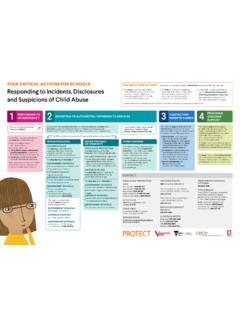Transcription of Creating a Culture - GOV.UK
1 Creating a Culture :How school leaders can optimise behaviour MARCH 2017 Tom Bennett Independent review of behaviour in schools 2 Contents Foreword 4 1. Executive summary 6 School Culture : the way we do things around here 6 Commonly found features of the most successful schools 7 Strategy recommendations for school leaders 8 Challenges that frequently impede improvement 8 Policy recommendations 9 Recommendations for the Department for Education to consider 9 Ofsted 10 How data was gathered 10 2 Introduction 12 Better behaviour benefits everyone 13 All schools, not some 14 Is there a behaviour problem?
2 A review of the evidence 14 Defining the problem 14 Evidence against 15 Evidence for 15 Teacher voice surveys key findings 15 Further evidence 18 Conclusions 21 What do we mean by good enough ? 22 Reframing what we mean by good behaviour: negative and positive 23 Is expecting good behaviour oppressive? 23 Commonly found features of the most successful schools 25 3 Recommendations for school leaders 30 Designing the Culture 30 Creating a vision of the school Culture 30 Making behaviour a whole school focus 30 Social norms 31 Communicating that Culture to the school community and beyond 31 Leadership team curation 32 3 4 Building the Culture in detail 34 Managing staff through transition 34 Teacher training 35 High expectations and consistency 36 School routines 38 School rules 39 Consequences and recognising the considerations for pupils with SEND 40 Internal
3 Inclusion units 43 Using cultural markers and levers to create cultures 46 Using premises to support behaviour 48 Attendance and punctuality 49 Technology 50 Role models 51 5 Maintaining the Culture 53 Reinforcing the expectations 53 Continuous professional development (CPD) 55 Sharing good practice with other schools 57 Parents, families and the community 58 6 Obstacles to developing cultures of good behaviour, and how to overcome them 60 Responses to these challenges 62 Appendix 1: Summary of ITT behaviour management recommendations: case study method 63 Appendix 2: Behaviour audit survey for schools/inspectors 65 Appendix 3: Literature review 68 Appendix 4: Bibliography 72 Appendix 5: Acknowledgements 75 4 Foreword School leaders are well placed to drive substantive, widespread school improvement in England.
4 The range of responsibilities are as broad as the measures by which they are held accountable. Even in the most difficult of circumstances, I have seen headteachers who have transformed the life chances for hundreds or thousands of young people . A student s experience in school remains one of the most insightful indicators of later life success in any one of a number of metrics. For many it is the best chance they will ever have to flourish. How they conduct themselves at school is crucial to that experience. Helping them develop good behaviour is therefore one of the most important tasks a school faces.
5 This report has developed from the previous work of the Initial Teacher Training (ITT) Behaviour Review Group, led by me. The Group was commissioned in 2015 by Rt Hon Nicky Morgan MP, then Secretary of State for Education, to review and advise the Department for Education (DfE) on ways to improve the core provision for training teachers in the initial phase of their careers. The resulting report concluded that there were substantive opportunities for improvement in both the content and pedagogy of how new teachers are trained to run classrooms and direct the behaviour. As that review progressed, it became increasingly clear that while a highly skilled workforce of teachers trained in a variety of reactive and proactive strategies was desirable, strong leadership could offer even greater possibilities for driving better behaviour in schools.
6 How a school was run was an even greater determinant of school behaviour than any one of a number of well-trained staff working in isolation. My objective was to understand what common factors, if any, could be derived from successful schools. Of particular interest was if there were any strategies or themes that could be successfully shared, and to what extent such strategies were contextual. I wanted to understand if there were any commonalities in successful behaviour systems, suggest impediments to achieving that success, and then conclude with a brief series of recommendations, both for school leaders and for policy makers.
7 This report is the result. I have seen some excellent practice in leading for good behaviour; we have some truly inspirational leaders in this field. My goal in this report is to capture and celebrate what they do, so that everyone can learn from it. This report showcases our school leaders at their best. The situation across the system is not perfect but is vital that we get it right. We should not settle for second best, we can build on the progress made to achieve great things for our students. 5 It has been an honour and a privilege to meet so many expert school leaders, and to visit so many wonderful schools as part of this process.
8 In truth, t here is a good deal of work to be done to improve matters. But there is equally a great deal of talent and ambition in the school system to meet that challenge. After several decades of relative neglect, it is reassuring to see behaviour once more in the spotlight and I look forward to a better future that we now have a chance to build. I hope this report is helpful to school leaders. It is a distillation of some of the best of their community s wisdom, and I have tried to represent that as faithfully as I can. Tom Bennett March 2017 6 1. Executive summary The national picture of school behaviour is complex, but numerous indicators suggest that it can be better in a great number of schools and contexts.
9 Every leader should consciously aspire to the very best behaviour possible in their schools as a matter of priority. There are a number of strategies that schools with outstanding behaviour use frequently, and these should be shared and made available to all school leaders in order for them to decide if they are appropriate for their schools. School Culture : the way we do things around here The way students behave in school is strongly correlated with their eventual outcomes. When behaviour in general improves throughout a school the impact is: students achieve more academically and socially time is reclaimed for better and more learning staff satisfaction improves, retention is higher, recruitment is less problematic1 Standards of behaviour remain a significant challenge for many schools.
10 There are many things that schools can do to improve, and leadership is key to this. Teachers alone, no matter how skilled, cannot intervene with the same impact as a school leader can. The key task for a school leader is to create a Culture - usefully defined as the way we do things around here - that is understood and subscribed to by the whole school community. Schools vary enormously in composition and context. Their challenges are similarly varied. It is therefore impossible to prescribe a set of leadership strategies that will guarantee improvements in all circumstances. However, many of the main challenges fall within a finite range of variety.














